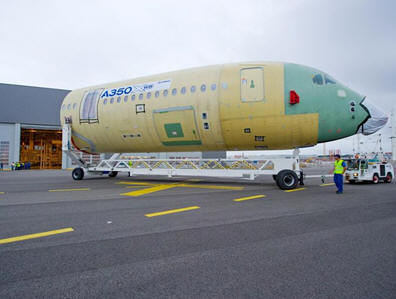|
The avionics will be a further development of the
integrated modular avionics (IMA) concept found on the
A380. The A350's IMA will manage up to 40 functions
(versus 23 functions for the A380) such as
undercarriage, fuel, pneumatics, cabin environmental
systems, and fire detection. Airbus says benefits will
include reduced maintenance and lower weight because IMA
replaces multiple processors and LRUs with around 50%
fewer standard computer modules known as
line-replaceable modules. The IMA runs on a 100-Mbit/s
network based on the avionics full-duplex (AFDX)
standard, already employed in the A380 instead of the
architecture used on the A330/A340.
The Trent XWB family comprises two basic engines to
power the three A350 variants. The baseline 370 kN
(83,000 lbf) thrust version for the A350-900 will be
derated to 330 kN (74,000 lbf) and 350 kN (79,000 lbf)
for the -800, while an upgraded 432 kN (97,000 lbf)
thrust version will power the A350-1000. The higher
rating 432 kN (97,000 lbf) engine will have some
modifications to the fan module - it will be the same
118-inch diameter but will run slightly faster and have
a new fan blade design - and some increases in
temperatures brought by new materials technologies
coming from its research programs.
The basic 248 t MTOW -800 will be offered with a 330 kN
(74,000 lbf) sea-level-thrust rating, while the 279 t
MTOW option will have 350 kN (79,000 lbf) thrust. Airbus
also plan to offer a 'hot and high' rating option
flat-rated at 350 kN (79,000 lbf) at higher altitudes
and temperatures which uses the full capability of the
-900's 370 kN (83,000 lbf) thrust engine prompted by the
operating requirements for Middle Eastern launching
customers Qatar Airways, Emirates, and Etihad.
The Trent XWB will feature a 118-inch (300 cm) fan
diameter and the design will be based on the advanced
developments of the Trent 900 (Airbus A380) and Trent
1000 (Boeing 787). The Trent XWB may also benefit from
the next-generation reduced acoustic mode scattering
engine duct system (RAMSES), which is a noise-dampening
engine nacelle intake and a carry-on design of the
Airbus's "zero splice" intake liner developed for the
A380. Engine thrust-reversers and nacelles will be
supplied by US-based Goodrich Corporation.
The A350 XWB will feature a 1,268 kW (1,700 hp)
Honeywell HGT1700 auxiliary power unit, which has
10% greater power density than the previous
generation of Honeywell's 331 APU family. Honeywell
will also supply the air management system: the
bleed air, environmental control, cabin pressure
control and supplemental cooling systems. The
ram-air turbine will be supplied by Hamilton
Sundstrand and will be located in the lower surface
of the fuselage. The generator requirement for the
ram air turbine is 100 kVA compared to 150 kVA for
the A380.
|



